Accord Hybrid Over-Runs Demands of Family Sedan
Filed under: Weekly test drives, Autos
By John Gilbert
BELLINGHAM, WASH.
My first after-Christmas auto review was going to be on the 2019 Honda Accord Hybrid, with the spectacular backdrop of the Pacific Northwest and Mount Baker. But that was before I got carried away describing the life-saving performance of our family Mini Cooper, making it home from Minneapolis to Duluth in a 6-hour battle against ice and whiteout conditions.
There’s still time. We can go back and evaluate the Accord Hybrid, but I must admit to being distracted by the spectacular scenery. No, not distracted driving; we stopped to admire the breathtaking views.
Without a doubt, the new Accord makes a strong impression, whether looking at it, riding in it, or driving. The EPA estimates for gas mileage is 47 miles per gallon city, 47 highway, and 47 combined. Makes sense. The Accord also performs with a strong, sporty flair that parallels the new looks.
The tenth generation Honda Accord came out as a 2018 model, and it is a curvaceous, attractive sedan that seems bigger than midsize. With styling cues from the exotic NSX sports car, the virtually unchanged 2019 stops folks in their tracks with its looks, especially from the front, where its thin string of LED headlights underscores the exotic appearance.
You could say this isn’t your daddy’s Accord, except that I was playing the daddy role during the trip.
I got a chance to test drive the new Accord Hybrid on our family’s Christmas trip to the Seattle-Bellingham areas of Washington, and several things jumped out at us immediately. First, there is enough room in the rear seat to hold a small convention, and the roominess is better than some large cars.

Stunning sunsets illuminate the shadows of Bellingham’s harbor and the San Juan Islands off to the West.
Second, there is considerable power from the hybrid system, which has a combination of a 2.0-liter VTEC 4-cylinder engine and a rechargeable electric motor device that, combines, produces 212 horsepower. I have no doubt the Accord Hybrid could have handled our venture from Bellingham up to the ski stations at the top of Mount Baker, but since the area had just been hit by over 2 feet of snow, we would be wiser to make the trek in younger son Jeffrey’s 4×4 Tacoma pickup.
The third noteworthy feature was that Honda is going with a continuously variable transmission, an electrically operated unit that uses belts and pulleys to enlarge or diminish in a system of never-shifting but always-shifting. CVTs have the nagging tendency of droning like a one-speed outboard instead of the stepped peaks of a normal automatic transmission. Honda wisely adds paddle shifters on the steering wheel to allow the driver to simulate manually controlled shifts and alleviate some of that inherent boredom.
I would grade Honda’s effort at B-, for at least trying to make it sporty.
The best part of a hybrid is to approach the spirit of a gasoline engine and provide a large increase in fuel economy from the electric motor input, knowing that the gas engine can spend its spare time recharging the electrical power.
Going back a couple of decades, to when Toyota and Honda were ferocious rivals to establish the major footprint on the hybrid market, Toyota had the Prius and Honda the Insight, and both tried to figure out how to turn their immensely popular midsize sedans into hybrids, so Honda put its system into the Accord, ahead of Toyota putting its system into the Camry.
It was fun talking to engineers of both companies, and I recall attending the earlier Accord Hybrid introduction when I questioned the engineers about why — when the gas engine’s primary duty is to recharge the battery pack — Honda didn’t use its exceptional 4 instead of the larger V6. They had their reasons, but I followed by asking what would happen if Toyota used its 4 with the hybrid when the Camry came out. That’s what happened, and when the Camry flashed better fuel economy, Honda was quick to discontinue the Accord Hybrid.
Hybrid technology has advanced all along, and the newest hybrids are remarkable in their smoothness and performance. Plug-in hybrids are even more efficient, and a logical step up as we transition toward all-electric vehicles. German hybrids from Audi, BMW and Mercedes have made their mark, and Hyundai has made amazing strides with among the highest technology in hybrids with the Ioniq and Sonata sedans, and the new Kona CUV.
Honda’s strategy is to bring out a newly designed Insight, while powering the rear wheels of its exotic NSX with electric motors, and bring back the Accord as a hybrid model. Most impressive, given that history, is that the new 2019 Accord Hybrid uses the potent corporate 2.0 4-cylinder engine to work with the electric power.
Because hybrid power is most efficient in stop and go traffic, city miles per gallon is usually higher than highway cruising — the opposite for gas-engine driving. Driving moderately can keep the gas mileage up near that magical 50 mark, and you certainly could top it with extra care.
When driving a hybrid, you want to let off the gas before needing to clamp hard on the brakes, and easing the brakes on for a slow stop enhances the recharging characteristics. Same with going down hills. In Duluth, for example, you might use a lot of available power zooming up the hills, but you also can recover a lot by braking lightly as you come back down.
The next most impressive thing about the Accord Hybrid is that it comes in a pretty loaded form, so no added options were necessary on our test vehicle, which had a bottom-line sticker of $35,605, decidedly reasonable because the standard roomy Accord sedan would cost just about the same, with the same features.
Those features include all the current items: rear camera, cross-traffic alert, lane keeping and lane departure assist, road-leaving mitigation, collision mitigation, remote start, front and rear parking sensors, and adaptive cruise. And it also adds some features that are pretty unique. Twelve-way power driver seat should keep you alert, but there also is a driver attention monitor to help keep you tuned in. Another is “walk-away locks,” which I wasn’t familiar with. But when we left the car unlocked briefly and came back to find it had locked itself, I was impressed. Honda always has been adept at unobtrusively making cars idiot-proof.
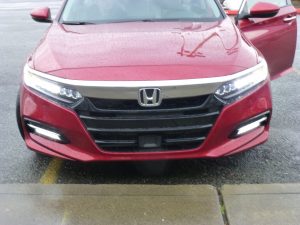
New-generation style, plus increased air-intake for hybrid engine cooling give Accord a distinctive look.
Honda always has been at the forefront of great handling and steering, too, and the Accord Hybrid takes that to a new level, with firm suspentsion and precise, line-carving trajectory around curves making full use of the well-tuned MacPherson strut front and multi-link rear suspension, and proving it is possible to coordinate electric steering and shift control.
It would take longer than we had to get comfortable with tuning tricks for the audio system, where Honda seems to have subscribed to rivals who make the simple tasks that used to be operated by round knobs for volume and selection needlessly complex.
Wherever you look, though, you realize that if you just bought a contemporary, roomy 4-door sedan, you could pay $35,000; if you bought a different vehicle with a contemporary hybrid system, you could easily pay $35000. The Accord Hybrid gives you both — a roomy super-sedan that is quick and handles well, and a hybrid powertrain that meets all requirements and delivers exceptional economy.
Good ‘Ol Mini Weathers the Worst Weather
Filed under: Weekly test drives, Autos
‘Twas the night after Christmas — OK, second night after Christmas — and all through the windblown snow not a creature was stirring on Interstate 35 between Minneapolis and Duluth, except for about a dozen other souls who had the same need to get there as we did.
Those others were in new pickup trucks or SUVs, mostly, and my wife, Joan, and I were in our trusty 2007 Mini Cooper, which has been our beloved companion for a decade and which has never let us down.
But this time was different. This time we were setting out from the Minneapolis-St. Paul International Airport at 11 p.m. for what would normally be a two and a half hour drive. Maybe three. But if you recall the second day after Christmas this year, it rained in the Twin Cities, which equated to about 15 inches of nasty, windblown, crusty snow on the North Shore outside of Duluth, and the trip from the Twin Cities to Duluth displayed every mixture of the rain/snow extremes, as Mother Nature seemed intent on playing tricks on anyone foolish enough to drive through it.
Driving new cars is a pure joy, even when the evaluation process might add a harness on the outright pleasure I could otherwise derive from test-driving the newest vehicles from any and all manufacturers. I also have always loved the adrenaline high of driving through the worst possible winter conditions.
As challenging and enjoyable as it is to drive the newest cars through all conditions, there is no doubt that the idea of owning a car means it must have all the attributes of a good Boy Scout — friendly, trustworthy, honest, loyal, thrifty, and all that.
Driving a car for a decade or so is one thing, and it is diametrically opposed to the switching from one new vehicle to another week after week for Newcarpicks test-drive reviews. Our family has found a reasonable solution, and that is to own a car that will work for the long haul. Joan generally does most of the driving in that vehicle, while I continue to test-drive new stuff, always encouraging her, and my sons, to also try the new cars and give me varied feedback.
At Christmas this year, we did what we’ve always wanted to do but have never before accomplished. I gathered up enough Delta SkyMiles coupons to get three round-trip tickets for Joan, our older son Jack, and me, to Seattle and back, to spend Christmas with our younger son, Jeff, in Bellingham, Washington.

Atop Mount Baker, the Gilbert Clan gathered: Joan, Jack, your faithful author, and selfie-shooter Jeff.
After talking over the most reasonable and efficient ways to pull it together, Joan and I decided to drive our 2007 Mini Cooper to pick up Jack on the way and head for the MSP air terminal. We did it and, thanks to Park and Go, we secured the car and got shuttled to the airport. It was a quick trip, as it always seems to be when you get your family together. The plan came about because Jeff was house-sitting — and mainly dog-sitting — for a good friend’s family, and they suggested inviting us out to stay at their place as well.
Wonderful time, with time to think amid the clamoring of the three household dogs. We’re getting to the age when we’ve stopped bugging our sons to get married and start families of their own. Apparently they’re having too much fun being single. But because of the unusually high number of close friends who have met untimely deaths in the past year, we need to savor every opportunity we have for the four of us to spend time together.
We enjoyed seeing the sights of Bellingham, with the seaside sunsets to the West and the majestic Mount Baker to the East, and Jeff showed off his new Tacoma pickup by driving us to the top of the Mount Baker ski area, where we had a great lunch and more sightseeing. They went from not having enough snow to being dumped on for about a 3-4 foot base now.
The dogs were predictably crazy. The big one, Nova, a mixture that resulted in her looking a lot like the old RCA Victor dog, had been around the two tiny dogs — Beckham and Barbara — so much we think she thought she was a lot smaller than she is, and could play too rough with her adopted siblings. But we enjoyed them, with room to let them run every day.
When it came time to leave, Jeff went off to work, and we said our good-byes to the dogs, locked up, and hi tthe road for Seattle, a couple of hours away. All went well, but I had seen the forecast on my trusty iPhone’s weather app. We landed at MSP and got shuttled to our car and the driver told us it had snowed early, but then just rain, which washed away most of the snow. We loaded everything into the Mini’s astoundingly spacious capacity and headed up I-35E. After we dropped Jack off at his house, the rain had turned to what they call a “wintry mixture,” and by the time we got up to North Branch, it was snow, blowing horizontal.
I noticed the Mini’s tiny engine never hesitated, but I also noted that our Nokian WGR-3 tires must be showing signs of age, because the car’s front end wanted to wander a bit. That is not a good thing, on an icy and snow-covered surface.
At North Branch, we found ourselves behind two plow-trucks who were running side by side at about 35 miles per hour. That was fine with us, although a couple of aggressive drivers passed us and seemed impatient to go that slowly. The plow trucks exited at Pine City, and we were on our own. We were particularly on our own when the three or four cars that had been with us all took off and disappeared in a cloud of blowing snow.
My sons both messaged us, urging us to stay at Jack’s, or at an inexpensive motel, but we wanted to get home — and to make a true confession here, I actually love to drive in severely harsh winter storms. That’s foolhardy, but ever since I learned to drive in winters on the Duluth hillsides, the adrenaline high I feel from the mandatory sharpened and heightened senses makes for a weird sense of achievement.
This was different, however. I apologized to Joan, because when she said she thought our tires might be wearing out, I scoffed that nearly worn-out Nokians were probably better than newer other tires. Curiously, the next day I stopped to see Jeff Hofslund at Foreign Affairs and told him of my concern, and that I was betting we’d gotten those tires five years ago. He looked it up on his slick computer and found that one day earlier was the five-year anniversary or our purchase of those tires. Driving them winter and summer, for about 50,000 miles, certainly had lessened their effectiveness.
That, of course, was after the fact. During the drive, we found no other cars out. The few who had driven off ahead were gone, and we never caught up to any others, and only two or three cars eased up behind us and passed, soon disappearing.
We didn’t keep up because the front end was wandering a bit, feeling like the bow of a speedboat in rough water. This wasn’t rough, it was completely smooth, but it also had a thorough covering of snow over the ice base underneath. We were driving with no lines visible, no side lane lines, no dotted center line, and no other tracks, with the passing cars tracks swiftly covered over.
Joan drifted off to sleep, assured that I was riveted to the task at hand, and I was glad she did. At least one of us could rest. The challenge of driving through what amounted to complete whiteout conditions presented interesting problems.
For example, there was no way to tell how much room there was on either side between the Mini and the edge of the road. So a few times, I eased over to the right until my tires caught the corrugated warning line for lane-departure, then I could ease back to what I figured was the center of the two lanes.
I glanced at the clock on the Mini dashboard and it said 3:30, and we were a long way from home yet. When I got near the Cloquet exits, I knew we were almost there. Coming down Thompson Hill, another car approached from behind, apparently unaware of the icy coating under the snow on the freeway. We pulled over and let him go.
The biggest challenge was yet to come. I headed out onto the highway heading East out of Duluth, and got to our road. All that was left was two miles of a long incline and we’d be safe and at home. However, it was obvious that the road had been plowed, but it had to be hours earlier, and it surely needed another plowing. What was left was a crazy pattern of rough, rugged lanes carved by tires to leave hard ridges about a foot high running longitudinally like ribbons
The poor Mini was churning onward and upward, with the front end, led by the license plate, actually plowing up snow that flew over the hood. I kept going, and as we headed up our final hill, the traction-control warning light flashed repeatedly, meaning we were spinning more than we were moving. We made it up most of the final hill, but the spinning increased and the movement decreased, right up until we were sitting motionless in the middle of our road. I backed down, carefully, and tried again, but the same thing happened again.
Then I had an idea. I backed down to the bottom or our hill, where I trusted that a neighbor across the road might be plowed out. He was. So I swung the rear end into his driveway and backed in. Then I pulled out, carefully, aimed down the road. At that point, I shifted into reverse and started calmly and smoothly to back up the hill.
Now, front-wheel drive is good for almost every driving condition, but going up a hill, there is a slight weight transfer from front to rear, lifting the downforce from the front drive wheels. So when you back up, any weight transfer goes to the front end, where more weight it a benefit over the drive wheels.
Sure enough, I backed up the hill, watching carefully to see if any headlight glow ight be approaching, but there was none. Our neighbors are smarter than to venture out in those conditions. I kept backing up, closer and closer to our driveway, until I could back through the final 90-degree turn and make it. I backed in about two-thirds of the way into the driveway our neighbor had graciously tried to plow into the 15-inch depth that was there.
We climbed out, carried all our luggage, and made it into the house, warm and secure as it awaited our arrival. It was 5:30 a.m., and the trip that I have often made in a bit less than 3 hours had taken 6 and a half hours.
Both of our sons stayed up all night, texting Joan to check on our progress. They couldn’t believe we made it, and they couldn’t believe how long it took us. They are both great people, but, of course, I’m prejudiced. There’s also a sensitivity factor involved. As we were leaving for the Seattle airport, Jeff had already left for work. We all gave each dog a final petting, and I must admit that they could be nuisances for much of the time we were there, but we had become attached in four days. In fact, when Jack made his final rounds of petting, I detected a tear in his eyes at the sadness he felt for leaving those dogs.
And now we were home. It occurred to me, though, that the severe spinning I encountered trying to make our hill might have been an indication that I had caused some damage to the transmission, and that it was the transmission slipping rather than the tires. Worrying about that, I also realized we had to make it, as matter of survival with each passing mile. We had to trust the Mini to carry us home, and it did.
At about noon, I ventured out to shovel my way to the car, worrying that there might be some damage to assess. I started it up, and it sprung to life. By then the roads and highways had been completely plowed, and I drove smoothly out onto our road, down the hill, and onto the freeway heading into Lester Park. I took it up to Foreign Affairs just to be reassured, and Jeff Hofslund laughed and said he knew the car would do the job, because he, too, owns one, which his wife likes so much she won’t let him sell it or trade it in.
If those rugged foot-high ruts of ice-hardened snow had broken something on the underside of the Mini, we would have had to consider it a necessary problem for getting home. I made an appointment to get some new tires, and an oil change, because the Mini was tougher than Old Man Winter’s icy blast. But it seemed the Mini had healed itself.
Because I rarely drive the car, I hadn’t realized there was a tiny little button on the console, just behind the shifter, where a driver couldn’t possibly see it. It was a button to engage the traction control. All the flashing lights I noticed blinking as we swayed on the icy freeway were blinking to notify me I was driving with the traction control inadvertently disengaged! I was blaming those aged Nokians and the Mini itself, and now I realize both were blameless. A less-clueless driver might not even have lost traction.
Still, getting it thoroughly checked is the least we could do to pay the Mini back for such superb loyalty. And maybe we’ll get a dog.
High-tech, Low Price Make Kona New Car Pick of the Year
Filed under: Features, Autos
By John Gilbert
The Hyundai Kona has earned the unprecedented honor of being named the 2019 “New Car Pick of the Year,” satisfying both the nation’s insatiable appetite for SUVs with restraint provided by the rational input from those of us at the website newcarpicks.com.
Among the numerous impressive and worthy vehicles filling every automotive segment these days, there are a number of worthy attractions for car buyers. But U.S. consumers have turned away from the lengthy list of outstanding new sedans and choosing to go with SUVs, the contemporary version of what we used to know as station wagons. Decades ago, we moved on to minivans, then to large SUVs, before falling back a bit to more reasonably sized sport-utility vehicles.
Hyundai, the South Korean conglomerate that has spent less than a decade vaulting from a mediocre bit player in the economy car business to a sensational company that learned the secrets of high technology, styling, and mechanical wizardry and has combined them all into attractive and appealing vehicles.
With the larger Santa Fe and Tucson SUVs finding success above a battery of fine cars from subcompact to luxury, the Kona is in a unique position to blend advanced styling and safe structure into a compact SUV — called CUV, for Compact Utility Vehicle. It is the perfect combination of all-weather all-wheel drive in a compact package large enough to carry some people, some luggage and equipment and yet small enough to be maneuverable — dare we say sporty? — in traffic congestion or twisty road regions. All of it comes in at a price that is remarkably reasonable, from $20,000-$30,000, which is just about half of what slightly larger SUVs try to command, even though they don’t have nearly the technical features that virtually fill the Kona.
This selection has no connection with the North American Car, Truck and Utility of the Year named this week at the Detroit International Auto Show. I was a member of that august jury for about a decade and a half, starting back when I spent 30 years writing about sports and cars at the Minneapolis Tribune. The North American Car of the Year jury decided to expand from a car of the year to add a companion truck of the year, and three years ago it added a separate SUV category, further diluting its choices.
For the record, that group also named the Kona its Utility of the Year, joining the Ram 1500 as Truck of the Year, and the Hyundai G70 sedan as Car of the Year. It is nice timing that Hyundai just recently decided to branch its largest sedans off under the name of its Genesis sedan, so those who might discriminate may not even realize that Hyundai, from South Korea, just claimed two of the three biggest prizes at Detroit.
Those three winners had been predicted in this column a couple of months ago, although we at newcarpicks.com remained undeterred about naming just one vehicle Car of the Year and taking it on as a project for the coming year to verify the choice. While test-driving every new vehicle that I can get my hands on, we will have our own Kona to run through long-term testing, with my wife, Joan, keeping track of every expense and describing little tidbits of pleasure or nitpicks we can find from driving and living with the vehicle. Occasionally our sons, Jack and Jeff, will provide further input.
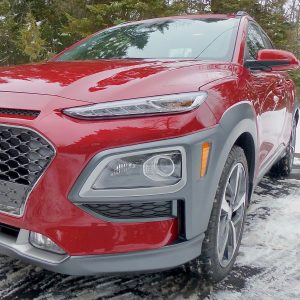
Array of lights include LED headlights, with foglights, driving lights and foglights separated stylishly on Kona’s front end.
The trend to go from cars to large SUVs never connected with us. My theory is “anything bigger than big enough is too big,” which was first aimed at gas-guzzling giant SUVs capable of hauling lots of large objects, even when you were commuting alone to work with no load.
Coming down to midsize SUVs made a lot more sense, and the recent surge of compact or crossover SUVs, built on efficient and economical car platforms, started proving to be viable alternatives to cars. The fact that the reduced price of regular gas reaching down to under $2.15 per gallon, was mere coincidence, although some companies were able to capitalize doubly because they were building much more efficient powertrains to take on the costlier fuel prices.
Now a fleet of compact SUVs or CUVs have captured the hearts of consumers, leading the way to the astounding fact that something like 72 percent of all the vehicles sold in 2018 were SUVs. No wonder Ford, General Motors and FCA are reducing the number of cars they build in favor of SUVs and pickups. When oil companies again find a way to raise prices, those who thought it was OK to buy larger and less efficient SUVs will unload them in a hurry for compact SUVs, which are almost as inexpensive to operate as compact cars. Of all of these, we think the Kona is the best new one, and a technological breakthrough besides.
The Kona comes in a variety of models, from the base SE, which starts with front-wheel drive, and a highly efficient 2.0-liter engine that delays valve opening by Atkinson cycle to give optimum economy with its 147 horsepower and 132 foot-pounds of torque. A 6-speed automatic and all-season tires on 16-inch alloy wheels make the SE look almost identical to the upscale models, and stability management and traction control, plus hill start assist and downhill braking control and all necessary connectivity makes it a bargain, bolstered by 33 mpg highway EPA estimates.
Moving up to the SEL, Kona adds 17-inch alloy wheels and a host of high-tech things, such as anti-theft immobilizer, blind-spot alert, lane-change assist, cross-traffic and side collision warning, push-button start, leather wrapped steering wheel and shift knob, heated front seats, HD and satellite radio and a hidden cargo area at the rear.
Move still higher and you get to the Limited, which accumulates all the SE and SEL features and adds the option of my favorite Hyundai engine — the 1.6-liter direct-injection 4-cylinder with a turbocharger, good for 175 horsepower and 195 foot-pounds of torque, operating through a 7-speed dual-clutch transmission.
The top-level Ultimate has all the attributes of the Limited, plus 18-inch alloy wheels, power tilt and slide sunroof, LED headlights and taillights, foglights, leather seats and automatic temperature control. Also standard on Ultim
All four models offer the option of all-wheel drive over the standard front-wheel drive. The small but potent turbo 1.6 has Hyundai’s own 7-speed dual-clutch transmission, in which two internal clutches alternate which one is engaged, with one handling first, third, fifth and seventh and the other shifting into second, fourth and sixth. You can do it manually, by moving the floor shift lever into the manual side, or you can let it shift for itself, precisely and swiftly.
We will devote our Car of the Year evaluations to the Ultimate model with AWD. We selected the Kona despite the obvious situation that the rear seat room is tight, compared to larger midsize SUVs. Son Jack climbed back there, and at 5-foot-10, he declared it to be a bit tight climbing in, but once inside, it was adequate for head and legroom and surprisingly comfortable. We could say the same, for certain, about the leather front bucket seats, very supportive and comfortable.
Within the overall length of 164 inches, the Kona has 39.6 inches of front headroom dropping to 38 inches with the power sunroof, with rear headroom of 37.8, and front legroom of 41.5 inches with 34.6 inches in the rear. Cargo capacity is a modest 19.2 cubic feet with all seats in place, expanding to 45.8 with the rear seats folded down.
Among the Star-Wars-y features is the Blue Link, which allows us to program the car’s connectivity with our iPhones. You of course can use the key fob to lock and unlock the doors or pop the rear hatch, but you’ll want to download the free Hyundai app. Summon it, and you can lock, unlock, open the hatch, and also activate the auto-start by clicking the proper icon and executing by Wi-Fi!
In Duluth, Minnesota, where the all-wheel drive works wondrously on all the hills, being able to fire up the car for a warm-up of up to 10 minutes is greatly appreciated when the temperature occasionally dips below zero. There are stories such as the woman leaving her key fob in the console and realizing it as she headed out into the cold. She called her husband, who was out of town on business and explained her predicament. No worries. He used his iPhone to lock the doors and remotely start the car, a couple hundred miles away, and set the interior temperature to 71 degrees. She walked to the car and called him again, and he unlocked the car from long-distance and she got in and drove away.
There are other manufacturers that build such features into their vehicles, but generally they cost at least twice as much as the Kona. Being a person who loves high-tech gadgetry but also is always looking for a bargain, finding the Kona with all those features for under $30,000 made it the overwhelming choice as our Newcarpick of the Year.
Holiday gifts range from cars to tires to starters
Filed under: Equinox, Features, Autos
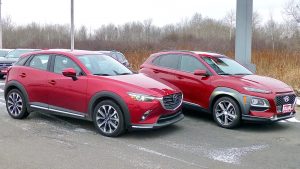
Two of the best inexpensive but high-tech compact SUVs are the Mazda CX-3, left, and the Hyundai Kona.
The model year changeover is extra intriguing this year because of the numerous and impressive bits of technology that have made their way into the automotive world. Here at Newcarpicks, we have whittled down the list of possible candidates for our Car of the Year down to the core, and the final decision will reflect the nation’s never-ending hunger for SUVs but will refuse to also recognize the seeming indifference to poor fuel economy that accompanies the quest for larer SUVs.
No, two of our finalists are more similar than different, and the second of those just arrived for a week-long examinaton in the Great White North. It is the Mazda CX-3 for 2019, which changes subtly from 2018 as a transitional vehicle in Mazda’s always-enticing lineup.
Gazing out at it in the early morning light at the Gilbert Compound on the North Shore of Lake Superior, I couldn’t take my eyes off it. It fairly glowed, like a large ruby, luring me to get out there and drive it. Somebody asked me what color it was, and I said I couldn’t remember the precise name, but it is a deep, lustrous red that goes right to your soul. Or at least my soul.
Then I examined the sticker to see if I could find the color.. There it was: “Soul Red Crystal” it said. Not bad. Maybe the fact I suggested the color went right through me to my soul was a tip. That color came out two years ago as a different and exclusive red on the CX-5, the midsize member of Mazda’s three SUVs. Last year it migrated to other models, where it will continue to be offered.
It turns out that Soul Red Crystal is a $595 option. I mentioned that to my inquisitive friend with the added note that it was a very expensive color, and probably worth it!
Swwms outrageous, perhaps, but I have never seen another color on any car, regardless of price, that affected me the same as Soul Red. So how much is it worth to have a distinctive color that lifted you up every time you approached the vehicle.
The CX-3 is a small SUV, too small by many contemporary standards, but the reason it is one of our finalists is that is loaded up with technology to match or surpass any other SUV, and it has some tricks that are beyond all the others.
As one of our two award leaders coming around the final turn and heading down the homestretch, the CX-3 is opposed by the Hyundai Kona, the smallest SUV offering from that South Korean company, and it, too, comes loaded with technology that other low-priced SUVs can’t hope to challenge.
That, too, looks good in its vast array of colors, but the red one stands out. Together, the two look like later Christmas tree ornaments.
Ah, Christmas is drawing close, and those of us who have family members or close-enough friends deserving of a holiday gift — which includes about all of us! — might leave us baffled about what we could get them that would be really different. Unique, even.
Buying a new vehicle for someone isn’t always possible, but if you need a new vehicle right about now, the CX-3 and the Kona are both available for right around $25,000, which is a modest price, especially when you examine the technology.
There are, of course, other wonderful Christmas gift ideas for a lot less than $25,000.
One is a set of winter or all-season tires, and the idea of the newest Nokian tires was appealing enough that I drove up to Ninth Street and Seventh Avenue East on the Duluth Hillside to talk to Jeff Hofstedt, propriator of “Foreign Affairs,” a cleverly named service outlet for all cars foreign or domestic, and also the nation’s leading seller of Nokian tires.
There are three or four different models of Nokians these days. I remain loyal to the all-season tires, stopping short of the all-out winter tire, the Hakkapeliitta. Without question, the Hakkapeliittas are the best winter tire on the market, matching the legendary Bridgestone Blizzak in glare-ice tracton, and outlasting even that stalwart for long wear in all conditions. I’ve found the WRG, and its newest derivative, the WRG-3, to be outstanding year-round, and still with exceptional snow and ice traction characteristics to get you through the harshest winter.
Both Car and Driver and Motor Trend finally got past the Tire Rack tradeout arrangement for using that company’s test track with the gentleman’s agreement deal that their annual winter tire test would only use winter tires sold at Tire Rack’s mail-order business. Nokian, a company in Finland which, Hoffstedt said, “invented the snow tire,” prefers to sell to smaller dealers and doesn’t go through Tire Rack, meaning Car and Driver and Motor Trend spent all those years comparing winter tires and declaring a winner while exclusing the best — the Nokian. The Hakkapeliitta won the top award by both magazines when they went to the company’s Finland home and tested above the Arctic Circle. I was hoping they’d include the WRG-3, because as an all-season tire, its unique tread compound sticks better than the snowtires of many competitors. Read more
Ford conducts intramural Car-SUV duel
Filed under: Weekly test drives, Autos
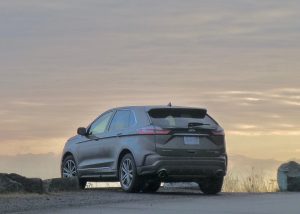
Newest Edge takes 2019 center stage for Ford, which is moving toward the Mustang vs. all-truck-SUV lineup.
If it’s time for a new family car, and your budget is sorted out, and now comes the ultimate decision. Do you buy the car of your dreams, or do you give in to the overwhelming trendiness but expansive versatility of a sports-utility vehicle?
If you happen to favor Ford Motor Company, you can face the decision in the same showroom:Like a major prize-fight, we have, in one corner, the flashy Mustang GT, with its swept-back roofline and spectacular color, and in that corner, we have the all-newly redesigned Edge midsize SUV. Both have their proper measures of appeal.
It might depend on your family. With the Edge you can haul the family anywhere, vacation trips, hockey practices, or to the shopping center, with all the comforts of home. With the Mustang GT, you will attract attention every time you start the engine, or cruise the neighborhood, resembling a slightly aging hot-rodder.
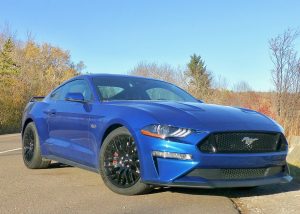
The Mustang GT Coupe Premium with 460 horsepower and precise handling is the best example of Ford’s car offerings.
There are benefits to both extremes, one of which lures your logical, family-oriented self, and the other which genuinely stirs all those primal juices of emotion. Pragmatic or passionate? You get to choose.
Maybe we really have gone over the edge in our society — I mean in car selection, not in politics — and maybe we really do prefer trucks and SUVs to cars. Or maybe we don’t, but are victims of auto manufacturers who are eager to build us SUVs and trucks rather than cars because they can push them out the dealership doors for three or four times the profit.
Whatever, we keep hurtling down that highway to changing the family car for the family truckster, and a perfect example of the whole societal shift is Ford Motor Company.
Ford can be excused for being truck-crazy, because it builds the F-150, which has become the most popular vehicle in the country, in fact the world, and continues to dominate the hotly competitive pickup segment.
Where it gets curious is that Ford executives announced several months ago that it will stop building several popular models of cars, and devote more attention to trucks and SUVs. The first word was that Ford would eliminate all but the Mustang and the compact Focus, then we heard only the Mustang will continue, in Ford’s drive to truck nirvana.
We know the Mustang is alive and well as it continues its amazing story of survival that started with its stunning introduction in 1964. The new one came out all new for 2018, so we don’t expect anything major when the 2019 model arrives. Just as well. It’s hard to imagine many improvements that could be made on the 2018 — especially the Lightning Blue GT model that arrived just before winter’s first blast.
Good thing, because with its 5.0-liter, dual-overhead-camshaft V8 spewing 460 horsepower and 420 foot-pounds of torque to the huge rear tires, your chances of avoiding slippage on a slippery roadway are slim, taking the heart-in-your-throat quotient sky-high in an instant. The 10-speed automatic can harness all that power, but only with judicious use of the gas pedal. Read more


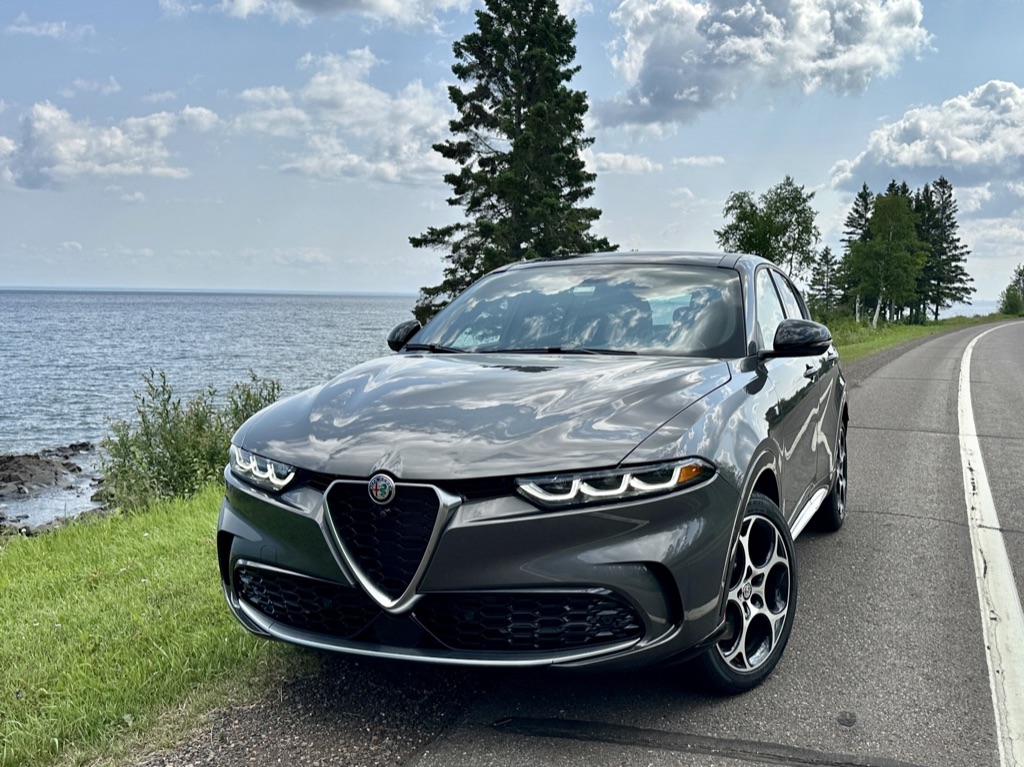


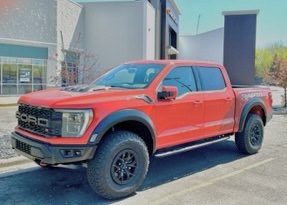

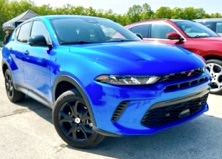


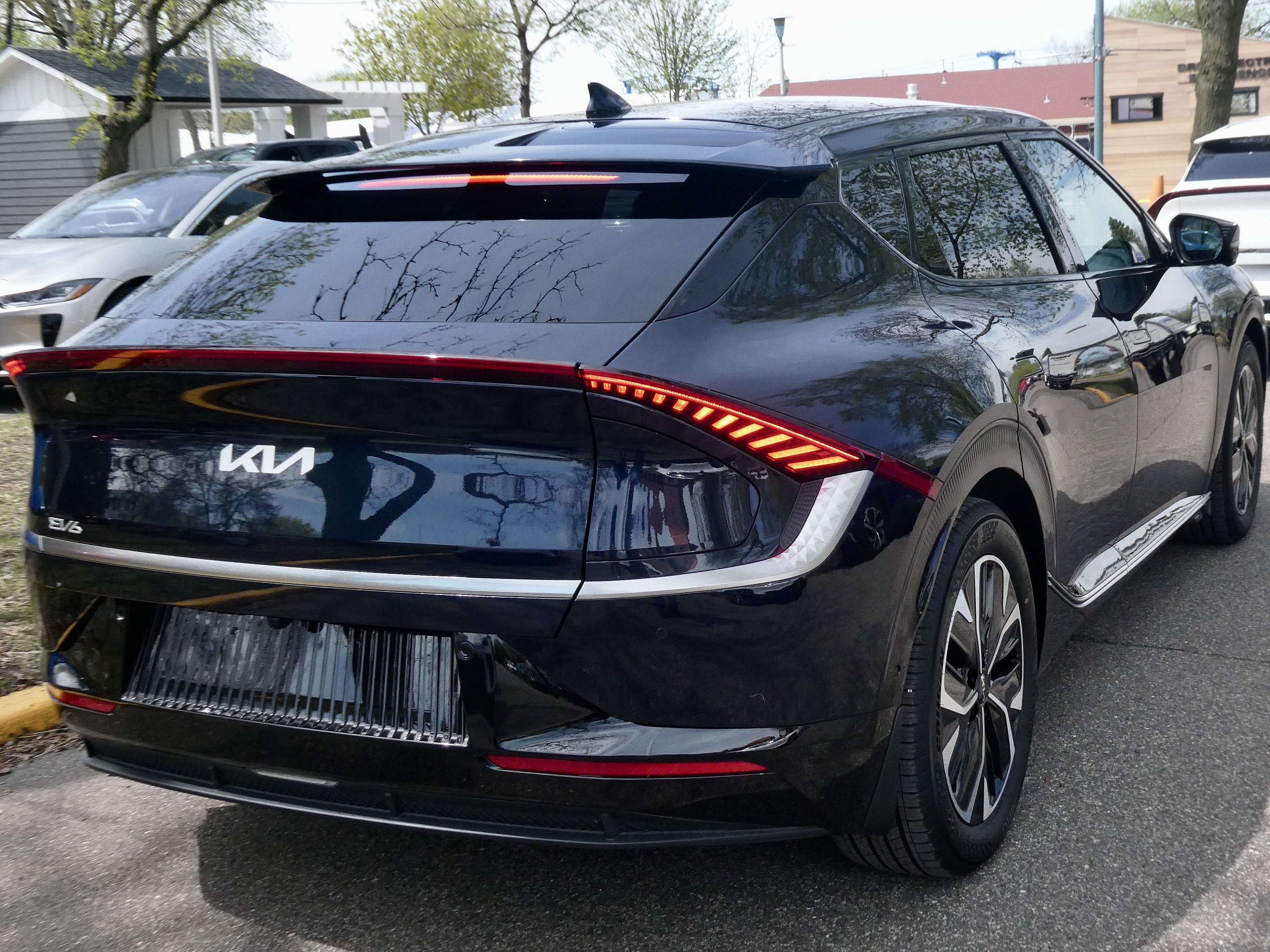
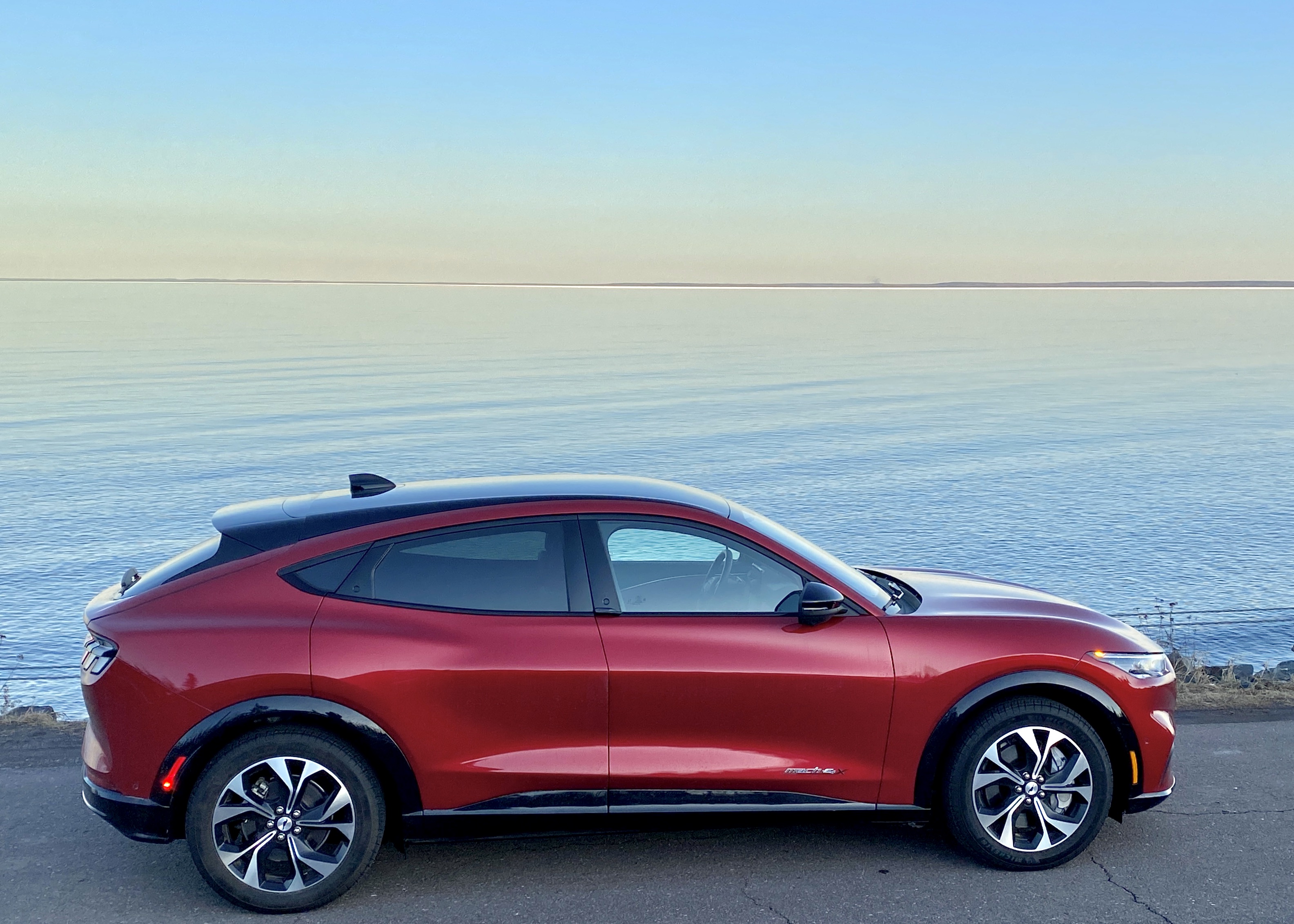

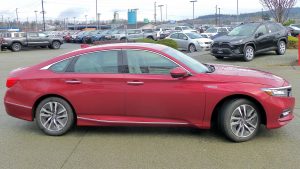
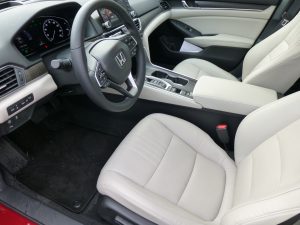



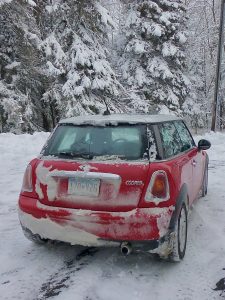


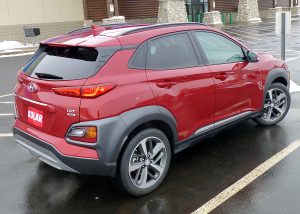
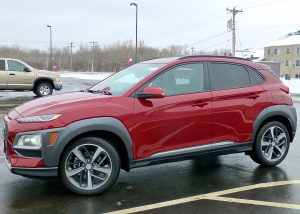

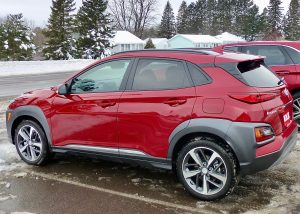
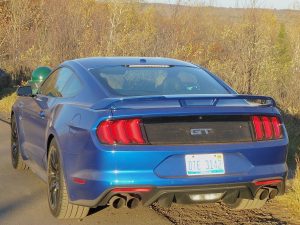
 John Gilbert is a lifetime Minnesotan and career journalist, specializing in cars and sports during and since spending 30 years at the Minneapolis Tribune, now the Star Tribune. More recently, he has continued translating the high-tech world of autos and sharing his passionate insights as a freelance writer/photographer/broadcaster. A member of the prestigious North American Car and Truck of the Year jury since 1993. John can be heard Monday-Friday from 9-11am on 610 KDAL(www.kdal610.com) on the "John Gilbert Show," and writes a column in the Duluth Reader.
John Gilbert is a lifetime Minnesotan and career journalist, specializing in cars and sports during and since spending 30 years at the Minneapolis Tribune, now the Star Tribune. More recently, he has continued translating the high-tech world of autos and sharing his passionate insights as a freelance writer/photographer/broadcaster. A member of the prestigious North American Car and Truck of the Year jury since 1993. John can be heard Monday-Friday from 9-11am on 610 KDAL(www.kdal610.com) on the "John Gilbert Show," and writes a column in the Duluth Reader.